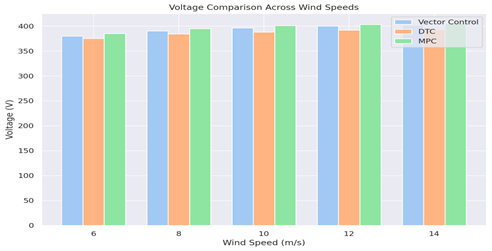POWER ELECTRONICS INTERFACES FOR WIND ENERGY CONVERSION SYSTEMS: DESIGN AND CONTROL STRATEGIES
DOI:
https://doi.org/10.71146/kjmr518Keywords:
Wind Energy Conversion Systems, Vector Control, Direct Torque Control, Model Predictive Control, Power Electronics, Harmonic Distortion, Voltage Stability, Power Output, Fault Recovery, Dynamic Response, Wind SpeedAbstract
This paper examines the behavior of three recently developed control methods, including Vector Control (VC), Direct Torque Control (DTC), and Model Predictive Control (MPC) on wind energy conversion systems (WECS). Such control methods are observed against key performance indicators such as voltage stability, power output, Total Harmonic Distortion (THD), response time, fault recovery time, with the variation in wind speed at 6 m/s and 14 m/s. Its findings reveal that MPC always performs better than VC and DTC providing better voltage regulation, more power generation and the smallest amount of harmonic distortion at all wind speeds. Also, MPC had a quicker dynamic response and a quicker fault recovery than the other strategies. The prediction capabilities of MPC facilitate adaptation to variation in wind conditions and consequently this makes it especially suited to the optimization of wind energy system efficiencies and resilience, particularly in areas with highly variable wind resources. The study points to the strengths of MPC to enhance performance and grid compliance of contemporary wind turbine systems.
Downloads

Downloads
Published
Issue
Section
License
Copyright (c) 2025 Fahiza Fauz, Dr. Syed Sheraz Ul Hasan Mohani, Amjad Jumani, Mirza Aqeel Ur Rehman, Moeen Abbas, Muhammad Asif Ramzan (Author)

This work is licensed under a Creative Commons Attribution 4.0 International License.






